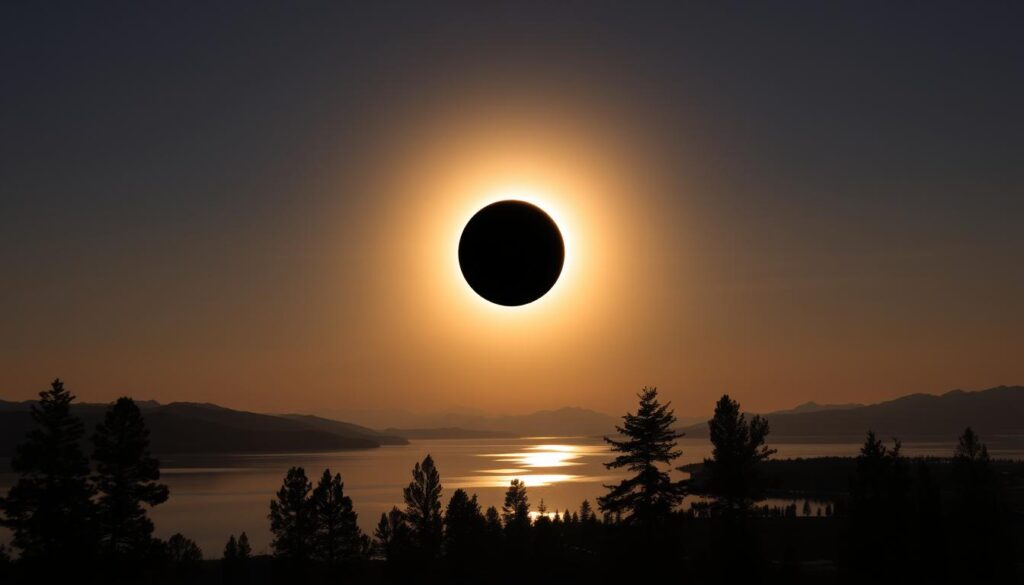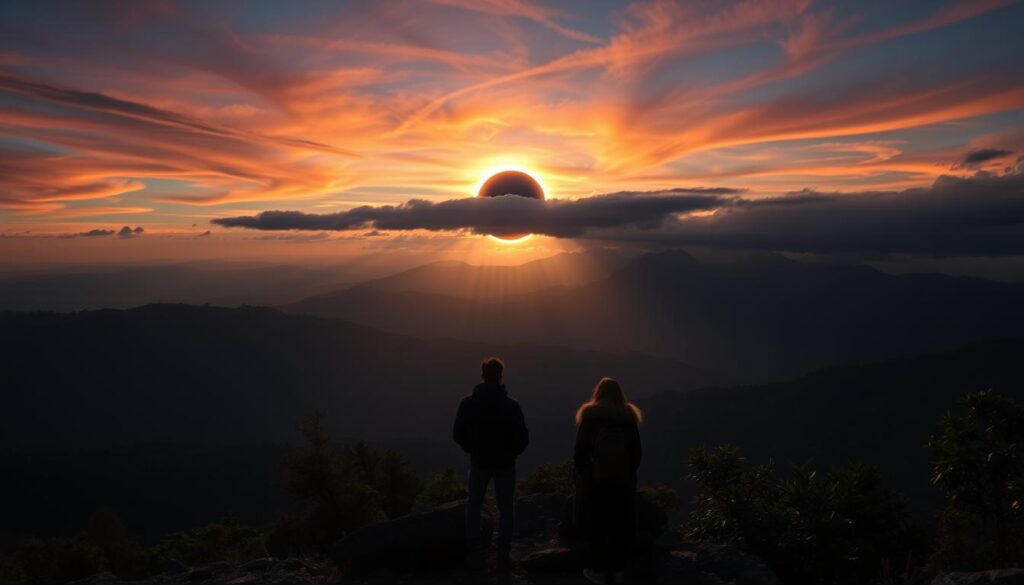
A breathtaking solar eclipse viewed from a serene landscape, with a dramatic darkened sky and bright corona surrounding the silhouetted moon, casting shadows over a tranquil lake reflecting the celestial event, silhouettes of trees in the foreground and distant mountains under the twilight hues of a fading day.
Step outside on a clear night and look up at the sky. You might see one of nature’s most amazing sights – an eclipse. An eclipse happens when one body in space, like the moon, blocks another, like a planet. This creates a stunning sight in the sky.
There are different kinds of eclipses. A total solar eclipse is when the moon covers the sun completely. A lunar eclipse happens when the Earth’s shadow falls on the moon. Both are incredible sights that can make you feel amazed and curious.
Key Takeaways
- Eclipses are astronomical events where one celestial body temporarily obscures another.
- Solar and lunar eclipses are the two main types of eclipses, each offering a unique and captivating display in the sky.
- Eclipses have fascinated humanity for centuries, inspiring myths, legends, and scientific advancements.
- Witnessing an eclipse in person is a truly awe-inspiring experience that can leave a lasting impression.
- Proper safety precautions, such as using approved eclipse glasses, are essential for safely enjoying these celestial wonders.
What is an Eclipse?
An eclipse is when something in space is blocked by another object’s shadow. This can be seen as a solar eclipse or a lunar eclipse. Each type has its own special features and science behind it.
Types of Eclipses
There are two main kinds of eclipses: solar and lunar. A solar eclipse happens when the moon blocks the sun’s light. This creates a shadow on Earth. A lunar eclipse occurs when Earth blocks the sun’s light from reaching the moon, making it darker.
The Science Behind Eclipses
The science of eclipses involves the sun, moon, and Earth’s positions and movements. During a solar eclipse, the moon’s shadow falls on Earth, creating special patterns. In a lunar eclipse, the moon goes through Earth’s shadow, making it appear darker or reddish.
The moon’s phases also affect eclipses. They are determined by the moon’s position relative to the sun and Earth.
| Eclipse Type | Description |
|---|---|
| Solar Eclipse | Occurs when the moon passes between the sun and the Earth, temporarily blocking the sun’s light and casting a shadow on a portion of the Earth’s surface. |
| Lunar Eclipse | Happens when the Earth passes between the sun and the moon, causing the moon to be partially or fully obscured by the Earth’s shadow. |
“Eclipses are nature’s way of reminding us of the dance of the cosmos, a celestial ballet that unfolds with precision and grace.”
Eclipse: A Celestial Spectacle

A breathtaking scene of a solar eclipse viewed from a serene mountaintop, silhouettes of people gazing up in awe, with vibrant colors in the sky transitioning from deep blue to fiery orange and dark shadows covering the sun, surrounded by lush greenery and rocky terrain, capturing the ethereal beauty of this celestial event.
Seeing an eclipse is truly amazing, a chance to see nature’s incredible show. The moon moves between the sun and Earth, making the sky a stunning work of art.
The totality phase is the most amazing part. The moon blocks the sun, creating a spooky shadow. Then, the sun’s outer layer, the corona, shines with a magical light.
When the moon starts to move away, the diamond ring effect shows. It looks like a diamond shining through the dark moon. Next, Bailey’s beads appear, with sunlight peeking through the moon’s surface, making a pattern of beads.
“The solar eclipse is a very special, rare event that allows us to see the sun’s corona, which is normally obscured by the sun’s bright face. It’s a unique opportunity to study the sun’s outer atmosphere in detail.” – Neil deGrasse Tyson
These sights come from a special dance in the sky. They amaze and inspire everyone who sees them. An eclipse shows us the beauty of the universe, reminding us of its wonders.
Historical Significance of Eclipses
Eclipses have amazed people for thousands of years. They have inspired awe, wonder, and even fear in ancient times. The eclipse history and eclipse mythology of the past are rich and fascinating. Today, we still find eclipses captivating.
Myths and Legends
Many ancient civilizations have created myths and legends about eclipses. In these stories, eclipses were often seen as bad omens. They were thought to signal doom, disaster, or the gods’ anger.
- In ancient China, eclipses were believed to be caused by a celestial dragon devouring the sun or moon. People would ring bells and beat drums to scare the dragon away.
- The Aztecs of Mesoamerica thought eclipses meant the end of the world. They would make sacrifices to the sun god to bring back light.
- In ancient Greece, the philosopher Anaxagoras was jailed for saying eclipses were natural, not signs of divine displeasure.
Even with our modern understanding of eclipses, their beauty and cultural importance still amaze us all over the world.
| Ancient Civilization | Eclipse Mythology |
|---|---|
| Ancient China | Eclipses were caused by a celestial dragon devouring the sun or moon |
| Aztecs of Mesoamerica | Eclipses were associated with the end of the world, prompting sacrifices to the sun god |
| Ancient Greece | The philosopher Anaxagoras was imprisoned for suggesting eclipses were natural events |
“Eclipses have long been seen as important celestial events, whether omens to be greeted with ritual fear and trembling, or marvels to be witnessed with awe.”
When and Where to View Eclipses

A celestial view of an eclipse path across a vibrant landscape, showcasing the moon partially covering the sun, with a gradient sky transitioning from deep blue to twilight hues, silhouettes of mountains and trees lining the horizon, small groups of people gazing upward in awe, artistic representation of light rays emanating around the eclipse, capturing the wonder of nature’s spectacle.
Seeing an eclipse is a unique experience. It’s exciting whether it’s a solar or lunar eclipse. Knowing when and where to see it is key. The eclipse path and visibility help plan your viewing.
The eclipse path shows where to see the eclipse. It changes with each eclipse. By studying it, you find the best spots for eclipse visibility.
Today, we have tools for eclipse forecasting. They tell us when and where to watch. With eclipse planning, you won’t miss this rare event.
| Eclipse Type | Typical Eclipse Path | Visibility |
|---|---|---|
| Solar Eclipse | Narrow band across the Earth’s surface | Only visible within the eclipse path |
| Lunar Eclipse | Visible from the night side of the Earth | Visible from anywhere the Moon is above the horizon |
Planning for eclipses is important. With knowledge of eclipse visibility, eclipse path, and forecasting tools, you’re set. You’ll see this amazing event and make unforgettable memories.
“Watching a total solar eclipse is one of the most amazing and humbling experiences you can have.” – Neil deGrasse Tyson
Safe Eclipse Viewing Tips
Seeing an eclipse is a rare chance, but eye safety is key. Looking at the sun can harm your eyes, causing vision loss or blindness. To watch the eclipse safely, you need the right eye protection.
Eclipse Glasses and Filters
For safe viewing, use eclipse glasses or handheld solar viewers. They block harmful UV and infrared rays, letting you watch the eclipse safely. Don’t use regular sunglasses, even if they’re very dark, as they’re not safe for eclipse viewing.
You can also use solar filters on camera lenses, telescopes, or binoculars. These filters make the sun’s light safe for viewing, so you can take amazing photos without risking your eyes.
Important Point
| NO. | Important Points |
| 1. | About Us |
| 2. | Contact Us |
| 3. | Disclaimer |
| 4. | Privacy Policy |
FAQs of Eclipses
What is an eclipse?
An eclipse is when one body in space blocks another, creating a beautiful sight in the sky. This can happen with the moon blocking the sun (solar eclipse) or Earth’s shadow on the moon (lunar eclipse).
What are the different types of eclipses?
There are two main types: solar and lunar eclipses. Solar eclipses happen when the moon blocks the sun’s light on Earth. Lunar eclipses occur when Earth’s shadow falls on the moon, making it look darker or reddish.
How do eclipses occur?
Eclipses happen when the sun, moon, and Earth line up. In a solar eclipse, the moon’s shadow blocks the sun’s light on Earth. For a lunar eclipse, Earth’s shadow falls on the moon, changing its color.
What are the visual effects of an eclipse?
Eclipses are amazing to see. In a total solar eclipse, the moon blocks the sun, creating a “diamond ring” effect. The sky darkens, and the sun’s outer atmosphere is visible. During a lunar eclipse, the moon can turn reddish-orange.
What is the historical and cultural significance of eclipses?
Eclipses have fascinated people for centuries. They’ve inspired myths and superstitions in ancient cultures. Eclipses have also helped science, leading to new discoveries about the universe.
When and where can I view an eclipse?
You can see eclipses from different places around the world. The path of the eclipse and how long it lasts are important. Solar eclipses are only visible in a narrow area, while lunar eclipses can be seen from anywhere on the night side of Earth.
How can I safely view an eclipse?
It’s crucial to protect your eyes during an eclipse. Use eclipse glasses or handheld solar filters that meet ISO 12312-2 standards. You can also watch indirectly through a pinhole camera or by projecting the sun’s image. Always follow safety tips to enjoy the eclipse safely.

Pingback: Discover the Ecliptic: Earth's Path Around the Sun 1